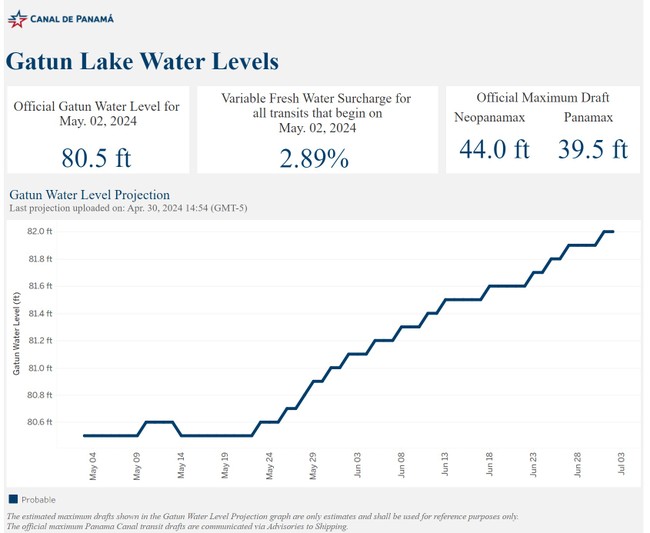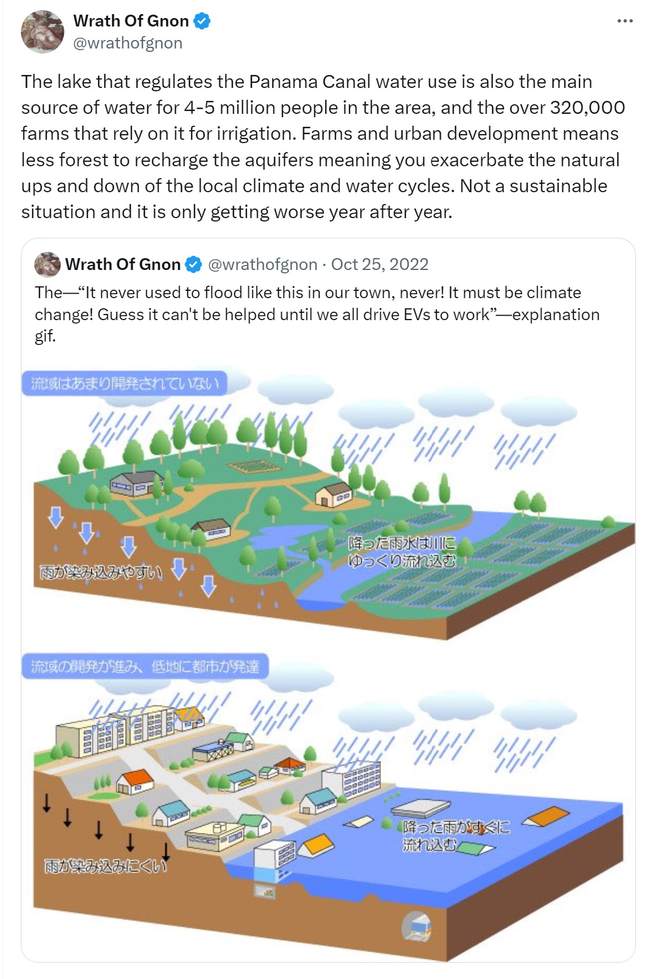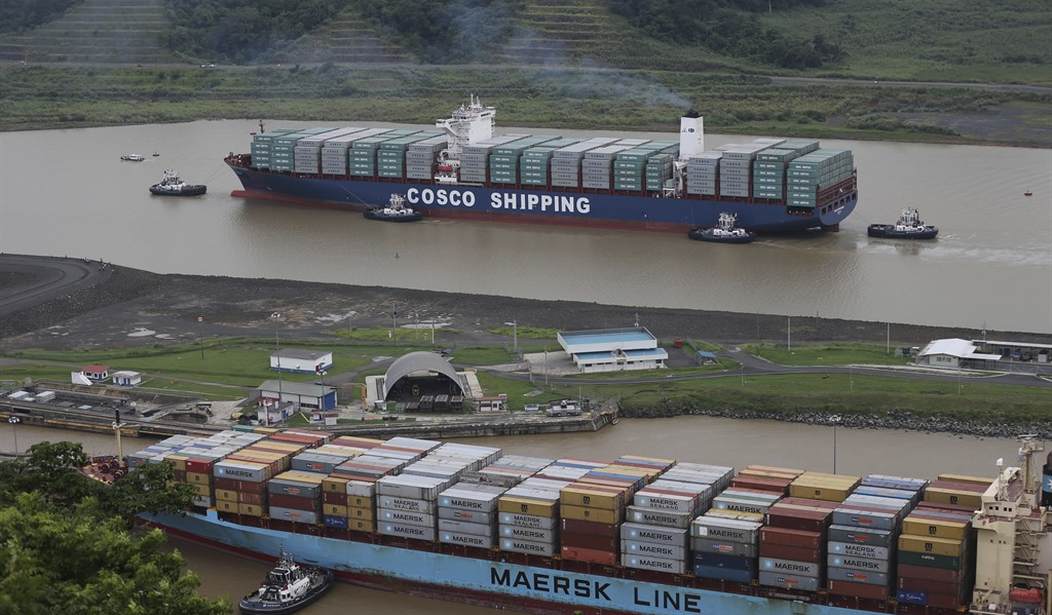No one is going to argue that it's been a rough couple of years for anyone who has to deal with the shipping industry and its challenges - which, to be perfectly honest, is all of us.
Of all the things we use and consume in the course of the day, a goodly percentage of each product or its ingredients/parts arrives via a boat from some far-off port.
COVID became the nightmare of simply trying to get a boat loaded to leave and arrive.
Over the course of the past year, it's been the interim part of the journey that's been the challenge, from dealing with the drought-stricken Panama Canal to Houthi attacks on shipping and then the explosion of violence following the Hamas terror attack on Israel with Iranians targeting shipping.
All of the default options have been closed off for transportation of goods around the world, and ships have been taking the long way home, both by necessity and for safety.
There might be a slight break in the bad news, and it comes with an interesting little sidenote attached for climate cultists desperately flogging the global warming narrative.
As far as the Panama Canal situation goes, things are looking up in a good, rainy, and wet way. Last August, they had a 20-day wait and a 200-ship transit backlog due to low water levels, which was forecast to worsen this past February. The Panama Canal Authority was planning to drop the number of ships even further.
...According to Panama Canal authorities, the drought requires them to reduce the number of daily transits from 29 to 25 ships and in the proceeding weeks, they will reduce vessels transits even more until it declines to 18 ships a day in February. That represents between 40%-50% of full capacity. Under normal conditions, between 34-36 vessels traversed the canal daily. The drought and vessel reductions are having a major impact on the flow of trade, according to data from CNBC Supply Chain providers.
But a number of things unexpectedly came together. The water levels, for one. Gatun Lake, as you'll remember, is the manmade freshwater feature that feeds the canal. It's been sitting at about 80 feet or so since November, and the authority became hopefully optimistic such drastic further cutbacks wouldn't be necessary.

And so it worked out. They never did have to cut back to 18 from 24 vessel passages a day.
In fact, by March, things had improved to where they could bump up a couple of extra slots thanks to "above average rainfall."
WELL, HUH
The Panama Canal Authority (ACP) has announced an increase in the number of daily transit slots available in the older Panamax Locks. The measures come in response to the current and anticipated water levels of Gatun Lake and increased demand for transit slots.
Starting March 18, two more Panamax slots will be available for auction, and from March 25, an additional slot will be introduced. This will increase the daily transits to 27, an improvement from the current 24 slots. The levels are still significantly lower than the 36 daily transits typically available.
Low water levels in Gatun Lake forced the Panama Canal Authority to reduce the capacity of the waterway in 2023 through daily transit and draft limits, in an effort to conserve freshwater. However, above average rainfall in November and December allowed the ACP to maintain 24 daily transits, rather than reduce the number to 18 in February as planned.
Two weeks ago, low and behold, there was yet another announcement. After completing some maintenance work, they again increased the transit numbers, and, even more important, the draft size of the ships allowed through the canal.
...On completion of these works ACP has announced measures that will increase the number of daily transits from 24 to 32, as water levels have improved following the drought last year that caused the implementation of restrictions.
That caused a cascade of readjustment in the larger shipping companies that had been improvising transit methods since their huge ocean cargo ships couldn't gain access to the canal. For example, shipping giant Maersk had offloaded its huge boats on the Pacific side, transported the containers on a train across the isthmus, and reloaded them aboard a boat on the Atlantic side. It was a pain, but still shorter and safer than going all the way around Cape Horn.
Maersk is reinstating Panama Canal transit for an Australia – US East Coast service as restrictions ease at the key waterway.
...Maersk split the Oceania – North America East Coast (OC1) service into two in January using a rail connection to move cargo across the Panama isthmus.
The Danish shipping line announced it will reinstate the Panama Canal transit on its OC1 service effective 10 May 2024 dropping the rail-land bridge link. The current “two-loop” setup established with the Panama Rail connection, which will be phased out by the end of May.
So already back to 32 passages a day compared to a historic average of 34-38...not bad. And everyone is optimistic, which in this day and age of gloom and doom must be annoying the hell out of someone. Particularly when they've worked so hard to convince us that the canal was going to dry up and never be viable again because it would never rain there again...probably.
CLIMATE CHANGE KILLED THE CANAL
...As climate extremes become more common, shipping companies, analysts, and governments fear the Panama Canal crisis may not be an aberration but the new reality. Scrambling to deliver their goods on time has led shipping companies to question whether the canal will remain a reliable artery of global trade—and sparked renewed interest in finding alternatives to the canal.
Boiling. And this Steven Paton guy's an Expert™ with "33 years" at his job "with the Smithsonian Tropical Research Institute" the article says.
Changing climate casts a shadow over the future of the Panama Canal – and global trade
...The question for the canal’s authority, global traders and the millions who rely on Lake Gatun’s reserves is whether the current water shortage is a one-off blip caused by El Niño, or a harbinger of the worst of what the changing climate could portend.
Armed with over a century of rainfall data, it’s a question that Paton is almost uniquely equipped to answer.
“I certainly am beginning to believe that the patterns we’ve come to know in the last 30 years are no longer a useful guide in helping us predict the future,” he says.
...“The increase in frequency is consistent with climate change models,” he says, “but the climate change models have not come out saying for sure.”
However, statistically what is going on now “has no analogue in the previous 100 years of data,” he adds.
Now, hang on a minute there Expert™! "No analogue" in the past "100 years of data"? There's a bit of news from a group whom I'm sure Paton would normally count on for back-up.
The climate hoaxers at World Weather Attribution @WWAttribution pretend to be even handed by arbitrarily deciding that emissions are not to blame for low rainfall at Panama Canal.
— Steve Milloy (@JunkScience) May 1, 2024
Don't be fooled. WWA is just making it up as it goes along so as to advance the climate hoax.… pic.twitter.com/7RS8tPpgIY
Milloy calls the World Weather Attribution "hoaxers" because they do have a rather well-established reputation for Science™ pronouncements instead of science.
...Between the lines: The climate study is from the World Weather Attribution group. Scientists affiliated with this project have found that human-caused climate change has boosted the odds and severity of many highly impactful extreme weather and climate events, particularly heat waves and heavy precipitation events.
- Some have criticized this loose-knit group of scientists for consistently finding climate change links to extreme events, despite sparse observational records in an area.
Even Axios is wondering if they're going to use the peer-reviewed methods employed for this study to boost their credibility. See, they used data from 140 YEARS of rainfall records.
And they used it in a proscribed scientific fashion.
It's odd how their in-depth work produced something diametrically opposed to what government-funded shill Paton claimed and what this group itself normally simply asserts without any data backing them up.
The climate phenomenon known as El Niño—and not climate change—was a key driver in low rainfall that disrupted shipping at the Panama Canal last year, scientists said Wednesday.
A team of international scientists found that El Niño—a natural warming of the central Pacific that changes weather worldwide—doubled the likelihood of the low precipitation Panama received during last year's rainy season. That dryness reduced water levels at the reservoir that feeds freshwater to the Panama Canal and provides drinking water for more than half of the Central American country.
Human-caused climate change was not a primary driver of the Central American country's unusually dry monsoon season, the World Weather Attribution group concluded, after comparing the rainfall levels to climate models for a simulated world without current warming.
...To test whether climate change had a role, the team of scientists analyzed weather data against computer simulations precise enough to capture precipitation in the region. Such models simulate a world without the current 1.2 degrees Celsius (2.2 degrees Fahrenheit) of warming since preindustrial times, and see how likely the lack of rainfall would be in a world without fossil fuel-charged warming.
The climate models did not show a trend similar to the drying that Panama experienced last year. In fact, many models show a wetter trend in the region due to climate change from carbon dioxide and methane emissions produced by the burning of coal, oil and natural gas.
Meanwhile, the analysis showed that El Niño reduced the 2023 rainfall by about 8%, and that it's unlikely Panama would have experienced such a dry rainy season without the influence of the weather phenomenon. The researchers said increased demand for water in the region worsened the shortfall.
The group used more than 140 years of rainfall records collected from 65 weather stations—a "statistician's dream," said Clair Barnes, a researcher at Imperial College of London and one of the study's authors.
It's almost as if rigorous scientific inquiry based on hard data, as opposed to repeatedly manipulating already biased computer models, puts out unexpected truths.
Another point that the climate cultists have left completely out of discussion concerning the Panama Canal's woes, but this survey took into account? Panama's exploding population and the fact that Gatun Lake is their primary freshwater source.
Well, hello.

Any convenient omission in a narrative attempt, I guess.
But you know, the dead giveaway - even before this exhaustive survey confirmed sneaking suspicions that the shrieking was the usual hype - were all the qualifiers buried in every last one of the stories about the drought, to begin with. The "in a 100 years," "accumulated in watershed 25.6% less than the average rainfall over the last 73 years," and "one of the TWO driest years in the country's history since record-keeping began 143 years ago" type qualifiers which tell you this has happened BEFORE. This is not a new occurrence nor a cataclysmic one-off.
But you're not supposed to make that connection. You're supposed to freak out NOW.
Also, you're not to make the connection that the previous drought cycles had nowhere near the current population, nor did the canal host massive container vessels using up to 50 million gallons of freshwater per ship to transit the locks.
Climate change and global boiling cultists would prefer to have you pulling your hair out and taking a sledgehammer to your car over something that has demonstrably happened before and was appreciably worse.
You can tell the "ONLY A NATURAL CLIMATE CYCLE" news left a mark, even considering the source. Some true believers are still rubbing the metaphorical bruise.
The low water levels that choked cargo traffic were more closely tied to the natural climate cycle than to human-caused warming, a team of scientists has concluded. https://t.co/59oQsVFNos
— NYT Science (@NYTScience) May 1, 2024
That's not at all what they said. It might be what the Times wants to hear.
Cope is an awful thing.
Then again, sometimes it's delicious.

As for the Canal Zone, today's weather forecast is partly sunny, with a good chance of showers.
Perfect.








Join the conversation as a VIP Member